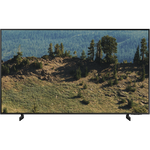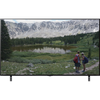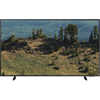A comparison of specs, key information, reviews, and best pricing from top retailers
Last updated -- hours ago | Report incorrect information
What we think

The PerfectRec TV team Learn more
Updated January 10, 2024·
If you're looking for better gaming performance with smoother motion and a higher refresh rate, the LG NANO90 would be the better choice. However, the Samsung AU8000 is generally less expensive and offers a little better picture quality for movies and TV shows. For dark room viewing, neither TV is optimal, but the LG has a slight edge. If you often watch TV in a bright room, the LG also has a better reflection handling. That said, the Samsung AU8000 has better black uniformity, which could be a plus for viewing dark scenes in movies. Give Feedback
this description is based on the product variant with some specs and product variant with some specs. At the time of writing, the variant with some specs cost some dollars and the variant with some specs cost some dollars.
Advantages of the LG NANO90 (LCD)
- Very good for gaming
- Good for use as monitor
- Good motion processing
- Very good reflections
Advantages of the Samsung AU8000 (LCD)
- The Samsung AU8000 (LCD) has no clear advantages over the LG NANO90 (LCD).
Key differences
Gaming
8.0


5.8
7.6/10
RESPONSE TIME SCORE
5.9/10
8.7/10
INPUT LAG SCORE
10.0/10
7.5/10
MOTION PROCESSING
6.0/10
50.0/100
GAMING LOCAL DIMMING
0.0/100
7.6/10
GAME HDR BRIGHTNESS SCORE
5.8/10
The LG NANO90 (LCD) is very good for gaming, while the Samsung AU8000 (LCD) is poor.
The LG NANO90 excels in gaming because it offers a good response time and very good input lag, which are critical for a smooth gaming experience, and it supports a higher refresh rate of 120Hz suitable for fast-paced games. In contrast, the Samsung AU8000, with its poor response time and lack of a high refresh rate option, is less optimal for gaming despite having very low input lag.
Cartoons & Animation
5.6


6.9
6.5/10
COLOR GAMUT SCORE
6.1/10
6.6/10
COLOR VOLUME SCORE
6.3/10
7.8/10
SDR BRIGHTNESS SCORE
7.1/10
4.3/10
COLORS OUT OF THE BOX SCORE
7.2/10
5.9/10
GRAY UNIFORMITY
6.8/10
The Samsung AU8000 (LCD) is only fair for cartoons & animation, while the LG NANO90 (LCD) is poor.
The LG NANO90 is rated poorly for cartoons & animation partly because its colors out of the box and color gamut are only considered fair, which means that animations may not appear as vibrant or accurate as intended. On the other hand, the Samsung AU8000 has a good score for colors out of the box, suggesting that it can display more accurate colors initially, without the need for calibration, making it a fair option for cartoons and animations.
Bright Room
6.9


6.3
6.3/10
VIEWING ANGLE
5.5/10
7.8/10
SDR BRIGHTNESS SCORE
7.1/10
7.2/10
HDR BRIGHTNESS SCORE
5.7/10
8.0/10
REFLECTIONS SCORE
7.8/10
The LG NANO90 (LCD) and Samsung AU8000 (LCD) are both only fair for bright room, though the LG NANO90 (LCD) is somewhat better.
The LG NANO90 manages reflections better than the Samsung AU8000, making it a more suitable choice for brightly lit rooms; however, both TVs exhibit only fair performance in terms of SDR and HDR brightness and struggle with color volume and color gamut, which are important for accurate and vibrant color reproduction in all viewing conditions.
Cost
$1,719


$648
$0
$500
$1,000
$1,500
$2,000
$2,500
$3,000
The LG NANO90 (LCD) has a price of $1,719 and the Samsung AU8000 (LCD) costs $648.

Let Us Help Find Your Perfect TV
Find your new TV
Key similarities
Picture Quality
6.1


6.6
5.28/10
CONTRAST
6.71/10
6.6/10
COLOR VOLUME SCORE
6.3/10
LED FALD
PANEL TYPE
LED
IPS
PANEL SUB-TYPE
VA
The Samsung AU8000 (LCD) and LG NANO90 (LCD) both have only fair picture quality.
The LG NANO90 has fair picture quality due to its poor contrast and local dimming, leading to unsatisfactory black uniformity, but it offers good color gamut and volume, ensuring vibrant colors. Conversely, the Samsung AU8000, also with fair picture quality, struggles with contrast and does not support local dimming, affecting its HDR brightness and color volume, although it has good color accuracy out of the box.
Movies & TV
5.6


5.9
5.28/10
CONTRAST
6.71/10
5.3/10
BLACK UNIFORMITY
6.9/10
7.5/10
UPSCALING
7.5/10
Yes
HDR10 SUPPORT
Yes
No
HDR10+ SUPPORT
Yes
Yes
DOLBY VISION SUPPORT
No
The Samsung AU8000 (LCD) and LG NANO90 (LCD) are both poor for movies & TV.
The LG NANO90 struggles with cinematic viewing due to its IPS panel which results in low contrast and poor black uniformity, adversely affecting dark scene performance, even though it has local dimming to slightly improve matters. On the other hand, the Samsung AU8000, while having better contrast thanks to its VA panel, lacks local dimming entirely, which means it can't enhance the depth of blacks in movies as effectively as TVs with local dimming, leading to a less immersive experience.
Sports
6.8


6.5
7.5/10
MOTION PROCESSING
6.0/10
120Hz
REFRESH RATE
60Hz
8.7/10
INPUT LAG SCORE
10.0/10
7.5/10
UPSCALING
7.5/10
7.8/10
SDR BRIGHTNESS SCORE
7.1/10
Yes
HLG SUPPORT
Yes
The LG NANO90 (LCD) and Samsung AU8000 (LCD) are both only fair for sports.
The LG NANO90 has better motion processing and response time than the Samsung AU8000, leading to smoother sports watching experiences, but its reflections handling is only slightly better and viewing angles are wider, which is beneficial for larger groups. The Samsung AU8000, while having poorer motion processing and response time which can result in more motion blur during fast sports scenes, handles reflections well but has narrower viewing angles which might limit the view for people sitting off to the side. Gray uniformity is somewhat better on the Samsung AU8000, which can positively impact the viewing of sports with uniform colors like a soccer field.
News, Talk, & Other TV
6.4


6.7
7.8/10
SDR BRIGHTNESS SCORE
7.1/10
7.5/10
UPSCALING
7.5/10
The Samsung AU8000 (LCD) and LG NANO90 (LCD) are both only fair for news, talk, & other TV.
When watching news or TV programs on the LG NANO90, you'll notice a fair color gamut and colors out of the box, along with decent SDR brightness, which is significant for daytime viewing. The Samsung AU8000, while excelling in contrast and also providing fair color gamut, lacks local dimming and thus may not deliver the same depth in certain scenes, but both TVs are adept at upscaling lower-resolution content to their native resolution.
Give feedback
We’re constantly working to improve.
How the LG NANO90 (LCD) and the Samsung AU8000 (LCD) compare to other TVs
Spec Comparison
| LG NANO90 (LCD) | Samsung AU8000 (LCD) |
GENERAL | |||
|---|---|---|---|
| Price | |||
$1,719 | $648 | ||
Brand | |||
Brand | LG | Samsung | |
Release Date | |||
Release Date | March 2, 2021 | March 4, 2021 | |
Full name | |||
Full name | 65NANO90 | UN65AU8000 | |
Screen Size | |||
Screen Size | 65" | 65" | |
Screen Resolution | |||
Screen Resolution | 4K | 4K | |
TV FEATURES | |||
|---|---|---|---|
Operating System | |||
Operating System | webOS | Tizen | |
Sound Quality Score | |||
Sound Quality Score | 6.4/10 | 6/10 | |
NextGen Ready | |||
NextGen Ready | No | No | |
HDMI Ports | |||
HDMI Ports | 4 | 3 | |
Coax Ports | |||
Coax Ports | 1 | 1 | |
DISPLAY QUALITY SCORES | |||
|---|---|---|---|
Picture Quality Score | |||
Picture Quality Score | 6.1/10 | 6.6/10 | |
Bright Room Score | |||
Bright Room Score | 7/10 | 6.4/10 | |
Gaming Score | |||
Gaming Score | 8/10 | 5.8/10 | |
Movies & TV Score | |||
Movies & TV Score | 5.6/10 | 5.9/10 | |
Sports Score | |||
Sports Score | 6.8/10 | 6.5/10 | |
PHYSICAL | |||
|---|---|---|---|
Dimensions w/o Stand (H x W x D) | |||
Dimensions w/o Stand (H x W x D) | 33" x 57.2" x 1.8" | 32.7" x 57.1" x 1" | |
Dimensions with Stand (H x W) | |||
Dimensions with Stand (H x W) | 35.6" x 57.2" | 34.4" x 57.1" | |
Weight without Stand | |||
Weight without Stand | 62.2 lbs | 46.1 lbs | |
VESA Mount | |||
VESA Mount | 400 x 400 | 400 x 300 | |
DISPLAY | |||
|---|---|---|---|
Color Depth | |||
Color Depth | 10 bit | 10 bit | |
Black Frame Insertion | |||
Black Frame Insertion | Yes | Yes | |
Auto Low Latency Mode | |||
Auto Low Latency Mode | Yes | Yes | |
Contrast | |||
Contrast | 5.3/10 | 6.7/10 | |
Local Dimming | |||
Local Dimming | 5.2/10 | 2.5/10 | |
SOUND | |||
|---|---|---|---|
Speaker Setup | |||
Speaker Setup | 2.2 | 2.0 | |
Speaker Power | |||
Speaker Power | 40 W | 20 W | |
Dolby Atmos | |||
Dolby Atmos | Yes | Bypass only | |
DTS:X | |||
DTS:X | No | No | |
Shopping
LG NANO90 (LCD)
See more
Dig into reviews and images
Techradar
John Archer | July 2021
"Here we have HDR pictures that look bright, but also manage to typically hit decently deep black levels.WebOS continues, though, to be one of the easiest to use. Connections are strong for a mid-range TV. Native 4K pictures look crisp and detailed."
Samsung AU8000 (LCD)
See more
Dig into reviews and images
USA Today
Michael Desjardin | April 2023
"To put it directly: you’d never see a mid-range 4K TV hitting this black levels half a decade ago. AU8000 plays the part of a higher-end TV thanks to its sleek design. If you’re upgrading to a smart TV for the first time, the software is a great way to dip your toes in the streaming water."
Get a great deal on the LG NANO90 (LCD) or the Samsung AU8000 (LCD)
About LG
LG, a prominent TV brand from Korea, has played a significant role in popularizing OLED TVs. OLED technology is hailed as the future of TV technology. Their TVs employ WebOS, a proprietary smart TV software that not only offers seamless functionality but also includes gaming-specific features, earning praise from players worldwide. Often regarded as the gateway to unparalleled viewing experiences, LG's mid-range OLEDs come highly recommended, making them a worthwhile investment for those willing to stretch their budget for superior quality.
About Samsung
Samsung, a South Korean electronics manufacturer, holds the title of being the largest global TV vendor in terms of units sold. They offer a diverse lineup of TV products that cater to various budget ranges. A notable achievement in recent years is the development of Quantum Dots, a technology that enhances color reproduction, resulting in richer and more vibrant hues. Samsung TVs are well-regarded for their high manufacturing quality and user-friendly software, making them an excellent choice for consumers seeking an intuitive viewing experience.
Give feedback
We're constantly perfecting our model
TV guides you might be interested in
More comparisons for you
FAQs
FAQs about TVs
Why trust us
This information was produced and vetted by the PerfectRec TVs team. We are a product research and recommendation organization that meticulously reviews and evaluates the latest TV information and makes it digestible for you.
By the numbers
385
TVs evaluated
33,110
TVs stats compiled
21
Proprietary TVs ratings developed
122,430
Recommendations made
18,365
Consumer hours saved
About the TV team
Joe Golden, Ph.D
CEO and TVs Editor
Joe is an entrepreneur and lifelong electronics enthusiast with a Ph.D in Economics from the University of Michigan.
Jason Lew
Staff Expert & Software Engineer
Jason is a staff expert and software engineer that has been making laptop recommendations for 7 years and moderates one of the largest laptop subreddits.
Chandradeep Chowdhury
Staff Expert & Software Engineer
Chandradeep is a staff expert and software engineer and expert in televisions and monitors. He’s been making monitor recommendations for ten years.
Jaime Roldán
TVs Expert
Jaime is a Colombia-based TV expert. He is an electronics engineer with 8 years of experience in the telecom sector and has been making TV recommendations for 12 years.







